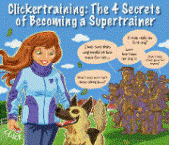Good Dog Training Advice
Get Fast & Simple Dog Training Tips to
Turn a Difficult Dog Into an Obedient Pet!
Dog Moulting Issues?
Dogs shed. They always have and they always will. It's not something we can actually get rid of (unless you're fond of a hairless dog). However, there are quite a few things that you can do to directly impact the frequency and severity of shedding in your beloved pet. 1. Grooming - Simple brushing of your dog on a daily basis can help with malting and shedding significantly. It will keep the coat softer, cleaner, and prevent shedding by reducing overall damage to the hair. Make sure to get a good brush that works well for your dog's coat. Shedding blades, love gloves, slicker brushes, and matbreakers are all good tools. The specific type of brush you use will depend largely on the dog's breed and hair type as well. 2. Good Food - Because shedding can be partly caused by poor diet, check to make sure your dog is getting everything he needs in his food. Here is a great dog food nutrition tip - high quality foods with digestible proteins and minimal empty fats and carbs are good for your dog's health. 3. Fatty Acids - Supplement your dog's diet with fatty acids to make their hair stronger and less likely to break. Vitacoat Plus is a good product for this. There are other, natural sources of fatty acids as well. Make sure to stay away from human food sources of fatty acids. Raw eggs are not actually a good thing to feed dogs due to the salmonella risk that exists there. 4. Allergies and Fleas - Allergies and fleas are a huge irritant for coat damage. Vitamin supplements like Vitacaps and Biotin are very effective in boosting the necessary antibodies to fight off allergies and fleas. Also make sure to use a flea medication every month to reduce the impact of fleas. Spot On and Advantage are both good products for this. 5. Cleaning Up - Not only does hair have a negative impact on the cleanliness of your house, it can make the shedding worse, by contributing to allergies, dry skin, and itching by your dog. Clean up hair as often as possible to reduce the impact of dust and hair. 6. Occasional Bathing - Dogs shouldn't be bathed too often, but a bath every 3-4 weeks in the summer can help reduce shedding. You can use a gentler shampoo once a week if you have severe dry skin problems that lead to shedding. Talk to your vet about which types of shampoo will minimize reduction in the necessary oils in your dog's coat. Also, make sure not to bathe around the time you use flea medication, or it will not work properly. 7. Check-ups with the Vet - More often than not, excess moulting is due to dry skin and the environment. However, in some cases, it can also be a sign of disease and should be seen to by a veterinarian. If you have tried the things on this list and find that your dog is still shedding or that their hair is coming out in patches or that it is growing back in thinly, you should see a vet immediately to rule out serious disease. Shedding is a natural part of our dogs' lifecycle. They do it to get rid of damaged, old hair, and when they have extra hair from the winter. If your dog continues to shed throughout the summer, after their winter coat is gone, it might be a sign that they need additional attention. By grooming your dog regularly, keeping her healthy, and watching for any signs of disease,you can effectively cut out a lot of that unwanted moulted hair. Because shedding can be partly caused by poor diet. I recommend that you check out 245 Healthy Dog Food Recipes below: | |
|


Discover the Secrets to Training Your Dog Or Puppy. Huge BONUSES for a limited time only!
Click here now...
|
http://GoodDogTrainingAdvice.com




